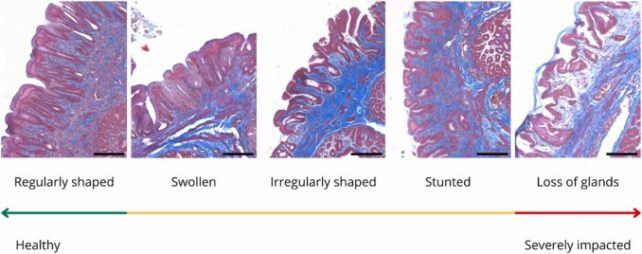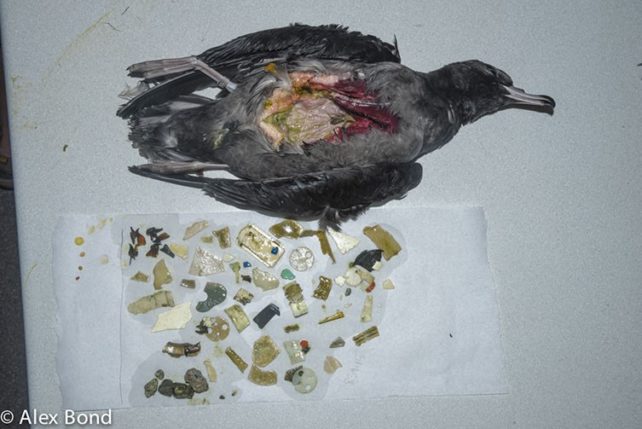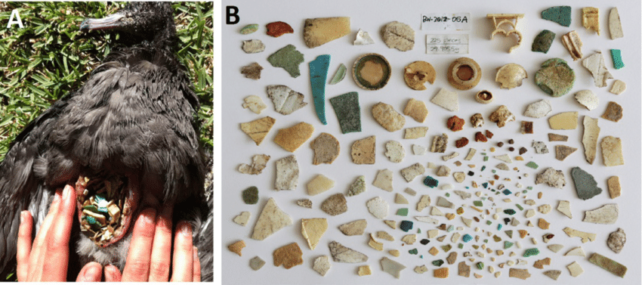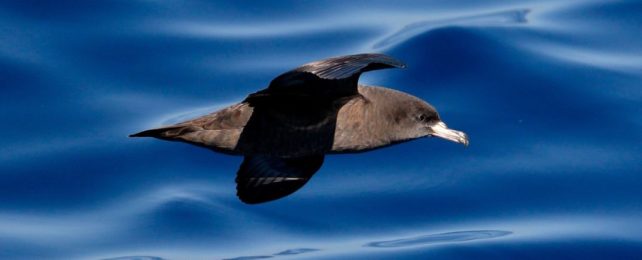One of the most plastic-contaminated birds in the whole world is silently suffering from a novel, emerging disease scientists have coined 'plasticosis'.
It's reportedly the first time researchers have ever documented and quantified the pathological effects of ingested plastic in wild animals, and it's got scientists stressing about the health of more than just one species.
The new findings suggest sharp plastic fragments can literally tear some seabirds apart from the inside.
"[T]his study clearly demonstrates the ability of plastic to directly induce severe, organ-wide scar tissue formation or 'plasticosis' in wild, free-living animals, which is likely to be detrimental to individual health and survival," researchers write.
"As plastic emissions continue to grow and plastic pollution becomes increasingly prevalent in all environments globally, it is likely that exposure of all organisms to plastic is inevitable," they predict.
Plastic pollution is thought to affect over 1,200 marine species at just about every level of the food web, and yet scientists still don't know what impact ingested or inhaled synthetic fibers and fragments are having on animal health.
When it comes to physical damage caused by ingested plastic, flesh-footed shearwaters (Ardenna carneipes) are the canaries in the coal mine.
These dark brown birds with pink feet nest on Lord Howe Island, a tiny and remote curve of land roughly 600 kilometers off the coast of eastern Australia.
Despite the sheer distance from human civilization, many of the chicks hatched on Lord Howe are suffering a slow and sickly death that seems to be all our fault.
Each autumn, gaunt and bedraggled fledglings litter the island's beaches, and for years now, scientists have been trying to figure out why so many of these seabirds are sick and dying.
When Australian researchers, along with a team from London's National History Museum (NHM), examined the carcasses of dozens of dead birds from Lord Howe, they found excessive and irreversible signs of scar tissue in stomach after stomach.

The extensive internal scarring is most likely caused by tiny bits of sharp plastic digging into a bird's internal lining over and over. Without the chance to heal, the first chamber of the bird's stomach, called the proventriculus, grows distorted with damage.
Last year, when Australian Geographic journalist Karen McGhee tagged along for a shearwater necropsy, she described a bird stomach so full of plastic it was "bulging… almost rupturing". The scientists conducting the necropsy counted 202 plastic pieces in total.
That's hardly an exceptional circumstance. Roughly 90 percent of necropsied birds on Lord Howe island have contained plastic in their stomachs.
The consistent scarring and chronic inflammation observed in seabird stomachs filled with plastic has scientists thinking this is a specific fibrotic disease.
They've called it 'plasticosis' to keep in line with other fibrotic diseases, like silicosis and asbestosis, which are also marked by tissue damage from pollutants, except in these cases the damage occurs in the lungs.
Damage in the stomach from plastic pollution has only been identified in the past two years, and most of this research has taken place in the lab among rodents. The plastic pieces tested were not properly weathered as they are in the wild.
Nevertheless, lab studies have shown that sharp, ingested macroplastics, around 5 millimeters in size, can block, ulcerate, or perforate digestive tracts, while also reducing feeding behavior. In severe cases, the animal can even starve to death.
The study among shearwaters is the first to show plasticosis occurring among wild animals.

In the hardened and inflexible stomach of a plastic-filled shearwater, room for new food is limited and digestion seems to be severely impacted. With so much scar tissue, scientists say the lining of the internal organ is not nearly as good at secreting digestive enzymes or absorbing nutrients.
The resulting loss of nourishment could be a key reason why so many shearwaters on Lord Howe are underweight. Since 2010, their average body mass has plummeted. And in the current study, higher numbers of plastic pieces in a shearwater's stomach were associated with a lower overall body weight.
"The tubular glands, which secrete digestive compounds, are perhaps the best example of the impact of plasticosis," explains Alex Bond, conservation biologist at the NHM.
"When plastic is consumed, these glands get gradually more stunted until they eventually lose their tissue structure entirely at the highest levels of exposure."

The consequences of ingesting plastic may not be the same for all seabird stomachs, or even all animal stomachs, but given the ubiquitous nature of ingested plastic in the marine food web, there's reason to worry about the health effects.
And that goes for our own species, too.
In humans, recent studies have shown people with inflammatory bowel disease (IBD) tend to have elevated levels of microplastics in their feces.
Among 52 participants, greater plastic exposure was closely aligned with the worst IBD symptoms.
That study was only small and does not establish cause and effect, but since microplastics have been found in human blood, placenta, feces, and the deepest parts of our lungs, toxicologists say we need urgent health assessments.
Ingested plastic can not only cause physical damage, it can also provide a way for parasites and microbes to hitchhike into the body. In addition, as plastics degrade, they may leech toxic and persistent chemicals with potentially dangerous health effects.
"[T]he ingestion of plastic has far-reaching and severe consequences, many of which we are only just beginning to fully document and understand," the authors of this study warn.
Plasticosis may be the first wildlife disease connected to plastics, but it may not be the last.
The study was published in the Journal of Hazardous Materials.
